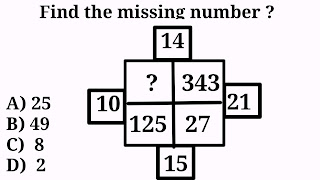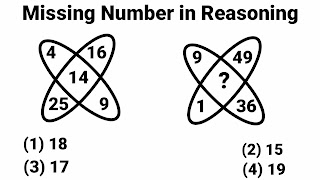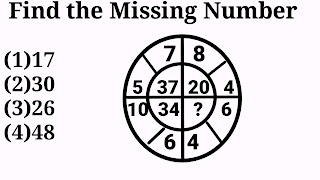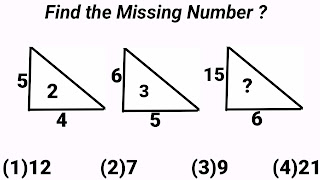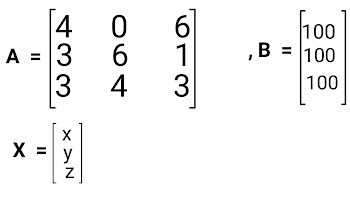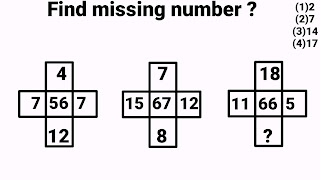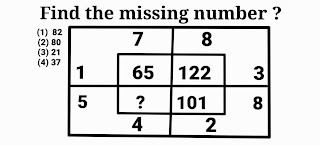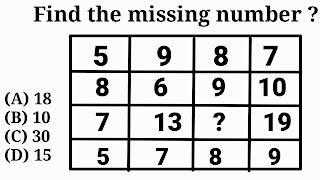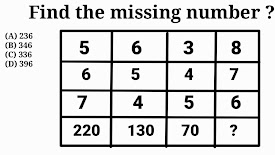Missing number in box Reasoning problem, How to solve various circle problems
Reasoning of missing number in box problems, circle problems and triangle problems will be discussed with the help of 10 most important examples. Some of these examples are of 4 × 4 order and other are of 4 × 3 orders.
Reasoning of missing number in box problems in Uniteted State
PROBLEM # 1
Formula
Calculation
PROBLEM # 2
Formula
Calculation
PROBLEM # 3
9² - 6² = 81 - 36 = 45 (1st Figure)
8² - 2² = 64 - 4 = 60 (2nd Figure)
7² - 3² = 49 - 9 = 40 (3rd Figure)
Option (1)40 is correct option.
PROBLEM # 4
9² + 6² = 81 + 36 = 117 (1st Figure)
8² + 2² = 64 + 4 = 68 (2nd Figure)
7² + 3² = 49 + 9 = 58 (3rd Figure)
Option (1)58 is correct option
PROBLEM # 5
 |
√? = 30/6 = 5, squaring both sides
Option (A)25 is correct option
Missing number series questions
Circle Reasoning
15 Questions Circle Problems
PROBLEM # 6
∛? × ∛343 = ∛? × 7 = 14
∛? = 14/7 = 2 cubing both sides
Option (C)8 is correct option
PROBLEM # 7
Option (3)17 is correct option
Reasoning of missing number in circle problems
This circle consists of four quadrants and every quadrant consists of three numbers . And every quadrant have two numbers in outer part and one number in the inner part . To find the value of question mark "?" , we shall use two numbers which are in the outer part to calculate the value of the number which is in the inner part of every quadrant .
1st Quadrant
Step 1. Take sum of the squares of both the numbers (8 and 4 ) in outer part of this quadrant.
Step 2. Take the magnitude of difference of both the numbers in outer part of this quadrant.
Step 3. Divide the result obtained in step 1 with the result obtained in step 2 to get the value of the number (20) in inner part of this quadrant.
Calculation
(8² + 4² ) ÷ ( |8 - 4 |) = ( 64 + 16 ) ÷ 4 = 80 ÷ 2 = 20
2nd Quadrant
Step 1. Take sum of the squares of both the numbers ( 7 and 5 ) in outer part of this quadrant.
Step 2. Take the magnitude of difference of both the numbers in outer part of this quadrant.
Step 3. Divide the result obtained in step 1 with the result obtained in step 2 to get the value of the number (37) in inner part of this quadrant.
Calculation
(5² + 7² ) ÷ (|5 - 7 |) = ( 25 + 49 ) ÷ 2 = 74 ÷ 2 = 37
3rd Quadrant
Step 1. Take sum of the squares of both the numbers ( 10 and 6 ) in outer part of this quadrant.
Step 2. Take the magnitude of difference of both the numbers in outer part of this quadrant.
Step 3. Divide the result obtained in step 1 with the result obtained in step 2 to get the value of the number (34) in inner part of this quadrant.
Calculation
(10² + 6² ) ÷ ( |10 - 6| ) = ( 100 + 36 ) ÷ 4 = 136 ÷ 4 = 34
4th Quadrant
Step 1. Take sum of the squares of both the numbers ( 10 and 6 ) in outer part of this quadrant.
Step 2. Take the magnitude of difference of both the numbers in outer part of this quadrant.
Step 3. Divide the result obtained in step 1 with the result obtained in step 2 to get the value of the number (34) in inner part of this quadrant.
Calculation
(6² + 4² ) ÷ ( |6 - 4 |) = ( 36 + 16 ) ÷ 2 = 52 ÷ 2 = 26
Option (3)26 is right option
Reasoning for bank exams
Ten Tricky logical reasoning
Reasoning questions with answers
Box Problems
PROBLEM # 9
Reasoning of missing number in triangle problems
PROBLEM # 10
2nd Triangle
3rd Triangle
Option (3)9 is correct option
Ten Most Important Reasoning questions with answers for competitive exams of series , box and other type with solutions have been discussed in this post . These types of problems are very helpful for cracking competitive exams like ssc cgl, ssc chsl and various Bank exams and many other similar exams. please feel free to comment your opinions





